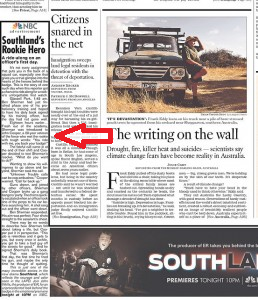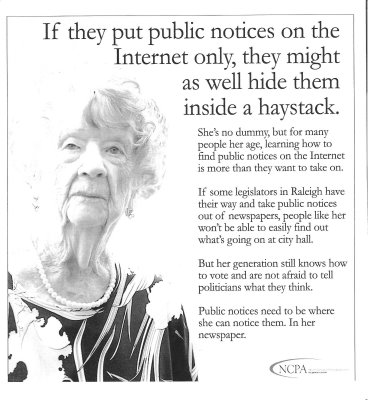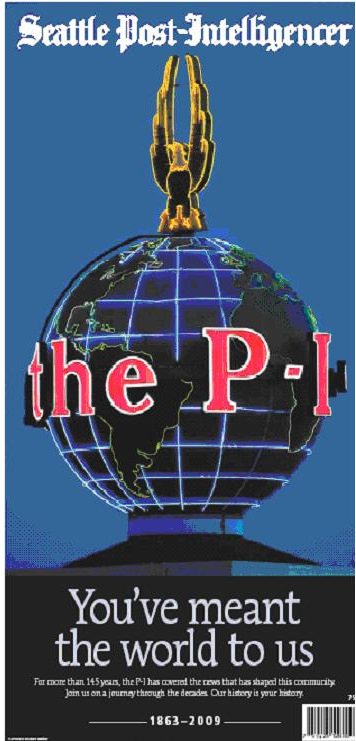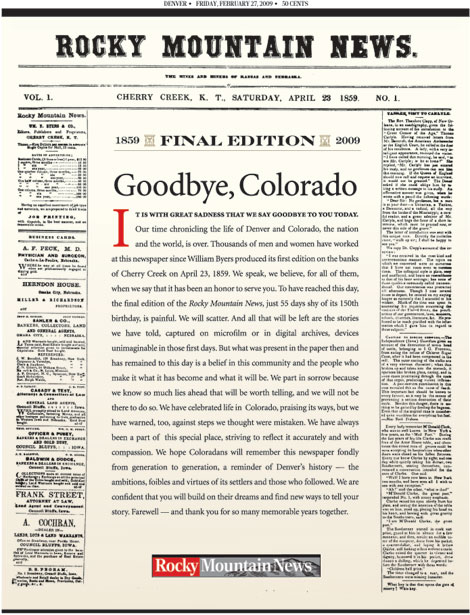As 2009 draws to an end, about the best thing anyone in the US newspaper industry can say about it is, “Thank God it’s over.”
This was unquestionably the worst year in the history of the business. Circulation plummeted to pre-World War II levels and advertising revenues hit regions not seen since the Johnson administration. The year opened on a dismal note with the closure of major dailies in Denver and Seattle and threatened shutdowns in San Francisco, Boston and Chicago. Many pundits predicted a bloodbath with dozens of dailies folding during the year.
But then the unexpected happened. Union concessions and deep cost cuts brought the Boston and San Francisco papers back from the brink. While smaller dailies did give up the ghost in Tucson and Ann Arbor – and more than 100 weeklies shut down – the doomsday scenario never occurred. Instead, publishers came to grips with the reality of their plight and made earnest attempts to stabilize their operations. In a January column on WallSt.com, former Financial World magazine and Switchboard.com president Douglas McIntyre listed “Twelve Major Media Brands Likely To Close In 2009.” In fact, only one – Gourmet magazine – did.
As the year wore on, signs emerged that sales declines are slowing and circulation revenue from the core of loyal readers is making up some of the advertising gap. A broad consensus has emerged that the ink-on-dead-trees model is mortally wounded, giving publishers permission to turn their attention from saving a dying industry to managing it profitably downward while investing in new ventures that have growth potential.
Creative revenue ideas ranging from pay walls to behavioral targeting sprung up this year. Enrollments in journalism schools hit all-time highs and undergrads said they are approaching their careers with the idea of building personal brand rather than working for a big metro daily. Many industry veterans applauded their spirit.
As the second decade of the new millennium begins, there is a palpable sense of optimism, not only about the economy but also the potential to reinvent journalism. It’s an attitude we have tried to encourage in our own small way, for this blog long ago turned its attention from death to rebirth.
We’ll be posting less frequently during the first six months of 2010 as we tackle a new book on business-to-business social media. Your comments and many words of encouragement have been a constant source of delight in this otherwise dreadful year. We wish you better times in 2010. Keep your chin up.
For now, here are some of the more memorable items from the 178 entries we posted this year, presented in no particular order
Uppers
- Doc Searles presented a well-reasoned argument why journalism isn’t disappearing from the earth but simply following the path already blazed by business. Much as personal computers and open source software moved computing innovation from the center to the ends of the network, journalism is undergoing a similar metamorphosis, he wrote. Journalism isn’t going away so much as being democratized.
 Life magazine published a delightful collection of classic photos – like the one of Los Angeles gangster Mickey Cohen at right – about the contribution of newspapers to our culture under the banner of When Newspapers Mattered.
Life magazine published a delightful collection of classic photos – like the one of Los Angeles gangster Mickey Cohen at right – about the contribution of newspapers to our culture under the banner of When Newspapers Mattered.
- The Library of Congress offered free access to a searchable database of dozens of daily newspapers stretching back to 1880. Nearly 1.5 million pages have already been scanned.
- A team of publishing veterans that includes Backfence founder Mark Potts and super-blogger Jeff Jarvis announced GrowthSpur. The startup is building a back-end business system that it hopes will enable bloggers and small publishers to quickly monetize their businesses while building a network that multiplies opportunity for every member.
- A team of veteran journalists and news technologists joined forces to create a technology to enhance the Web browsing experience while creating a new revenue stream for content producers. Startup CircLabs is developing a tool that learns from the user’s online behavior to deliver recommendations for relevant content. Founders include three top officials from the Donald W. Reynolds Journalism Institute at the University of Missouri.
- News-editor-turned-Silicon-Valley-entrepreneur Alan Mutter proposed ViewPass, a subscription service that would aggregate editorial content and collect visitor data that could be used to sell higher-priced ads. Mutter estimated that the system could more than double the CPMs that publishers charge advertisers and would manage copyrights more effectively than the current haphazard system.
- Former Rocky Mountain News Washington correspondent ME Sprengelmeyer penned a splendidly written essay about the joys of rediscovering his journalist roots as publisher of a small weekly newspaper.
- In a moving retrospective, Christian Science Monitor Editor John Yemma reminded us why he admired Walter Cronkite.
- “My beat at The Globe and Mail is the dead,” wrote Sandra Martin in a superbly written piece on the craft of obituary writing, one of the least understood and most often satirized disciplines in journalism.
- Writing in The New York Times, David Carr presented a glass-is-half-full perspective about the future of journalism. Carr observed that the new breed of technology-enabled young journalists see the collapse of media institutions as an opportunity to make a name for themselves based upon merit rather than survival. “The next wave is not just knocking on doors, but seeking to knock them down,” he wrote.
- A new Bay Area nonprofit was funded to the tune of $5 million by a local investor. The venture is a collaboration between public broadcaster KQED and the Graduate School of Journalism at the University of California at Berkeley.
- The Knight Foundation funded nine new-media projects to the tune of $5.1 million. The biggest winner was DocumentCloud, a project conceived by journalists from The New York Times and ProPublica to create a set of open standards for sharing documents. Other winners included one to help citizens use cell phones to report and distribute news, a project to develop a media toolkit for mobile applications and an online space where the people can report and track errors in the media.
Downers
- The New York Times published a jaw-dropping correction from its July 17 “appraisal” of Walter Cronkite’s career. Among the eight errors in the story where Wikipediable factoids such as the date of Martin Luther King, Jr.’s assassination. Ombudsman Clark Hoyt was blunt in his explanation: “A television critic with a history of errors wrote hastily and failed to double-check her work…editors who should have been vigilant were not.” The critic, Alessandra Stanley, has a history of being so careless with facts that in 2005, “she was assigned a single copy editor responsible for checking her facts.”
 The owner of Editor & Publisher, which has covered the newspaper industry for 125 years, announced that it will shut down the magazine.
The owner of Editor & Publisher, which has covered the newspaper industry for 125 years, announced that it will shut down the magazine.
- The bankrupt Tribune Company sent “14 reporters, columnists and photogs to this year’s Super Bowl, even though neither Super Bowl team came from a city where Tribune actually has a newspaper,” observed Mark Potts.
- The Printed Blog, a venture by serial entrepeneur Josh Karp that sought to flip the online publishing model by delivering blogs in print, shut its doors after just a few months.
- The Journal News of Westchester County fired all 288 employees and invited them to re-apply for 218 jobs. Managers had two weeks to conduct interviews and decide who got to stay.
- Many publishers apparently took advantage of recent changes to Audit Bureau of Circulation (ABC) rules to overstate their real readership numbers. The rules changes enabled publishers to count “bundled” subscriptions of paid and online editions as two subscribers, even if only one person was doing the reading.
- Ahwatukee (Ariz.) Foothills News staff writer Krystin Wiggs told of being victimized by an elaborate hoax concocted by a young man who claimed to be a gifted and successful chef. The man convinced Wiggs that he had won scholarships to culinary school and landed a sous chef job at a top restaurant at the age of 21. He even enlisted an accomplice to masquerade as head chef at the restaurant for a phone interview.
- BusinessWeek was put up for sale for $1. It was no bargain, since the legendary newsweekly was on track to lose $75 million this year. Bloomberg eventually paid up and then took a hatchet to the senior staff.
- After a tense four-month staredown with The New York Times Co., the Boston Globe’s largest union voted to accept a package of pay cuts, benefit reductions and other concessions that was worse than the one it had rejected a month earlier. The union chief was later charged with misappropriating funds by, among other things, faking a countersignature on his own paycheck.
- Sydney Morning Herald technology writer Asher Moses was publicly embarrassed over comments he made about a sex scandal involving a prominent former rugby star. Although the comments were made during his off hours, Moses’ impartiality was widely questioned.
- Amazon.com had a chance to win friends among the ranks of newspaper publishers by offering paid subscriptions to their products via the Kindle e-reader. Unfortunately, Amazon’s onerous licensing terms entitled it to keep 70% of the subscription fees.
- Todd Smith, who was shot on the job while working as a reporter for the Missouri-based Suburban Journals chain of newspapers, was called to a meeting at headquarters on April 15. Smith thought that maybe the staff had won an award for coverage of the massacre. Instead, he learned that he and several others were being laid off.
- Boston Herald Sunday editor Tom Mashberg reprinted an e-mail exchange between him and Keith O’Brien, the author of a harshly critical story about the Herald that appeared in the rival Boston Globe. The e-mail outlined O’Brien’s intention to include negative comments about the Globe in his story as well as the fact that the Herald was profitable while the Globe wasn’t. None of that information appeared in the final piece. “Looks like the editors got hold of this and turned it into a hatchet job,” Mashberg wrote.
 Washington Post publisher Katharine Weymouth (right) canceled plans for a series of dinners at her home after an overzealous Post marketing executive issued flyers positioning the events as a way for sponsors to buy access to the paper’s journalists and members of Congress. Weymouth said the promotions “should never have happened.”
Washington Post publisher Katharine Weymouth (right) canceled plans for a series of dinners at her home after an overzealous Post marketing executive issued flyers positioning the events as a way for sponsors to buy access to the paper’s journalists and members of Congress. Weymouth said the promotions “should never have happened.”
- French President Nicolas Sarkozy said his government would double its advertising in print and online newspapers in an effort to prop up an industry that many people believe needs a radical overhaul more than money. That’s on top of previously announced subsidies that give every 18-year-old French citizen a free newspaper subscription.
- The Chicago Tribune’s marketing department launched an experimental project to seek feedback on stories that hadn’t yet been published or even fully reported. A group of 55 reporters signed an angry e-mail in protest. Editor Gerould Kern issued a statement calling the experiment “a brief market research project.”
- A survey of 1,400 people by Britain’s YouGov found that media people consume an average of 44 drinks a week, or almost twice the recommended maximum.
- In a Vanity Fair profile of New York Times Co. CEO Arthur Ochs Sulzberger, Jr., Mark Bowden described one management offsite exercise in which Times Co. executives played a game that challenged them to decide between safe choices and riskier but potentially more rewarding long shots. An employee who had seen many groups play the game observed, “This is the most conservative group I have ever seen.”
- The Houston Chronicle devoted just 208 words to news that it was laying off 12% of its staff, or nearly 200 people. In fact, the Chronicle didn’t even mention a body count. A Wall Street Journal story was the source for the number.
- A press release from the Washington Times, as reprinted on Talking Points Memo, also buried the lead about its own bad news: “The Washington Times today announced that it will begin producing a more focused Monday through Friday edition designed to feature its most distinctive news and opinion content.” In other words, it was killing the Sunday edition.
- Kubas Consultants polled 500 newspaper executives in November and found them to be optimistic that the worst is almost over. Blogger Alan Mutter e-mailed the researcher who conducted the survey and learned that even he didn’t believe the resutls. “Optimism is better than slitting your wrists,” reasoned Ed Strapagiel.
- A new newspaper in Detroit, the Daily Press, published just five issues before hitting “a bump in the road” and suspending further operations until the new year.
- ZDNet blogger Richard Koman alleged that Yahoo had passed the names and e-mail addresses of hundreds of thousands of bloggers to Iranian authorities during the country’s controversial election. It turns out Koman‘s unnamed source for the story was an Iranian blogger with a vested interest in spreading misinformation. Paul Carr ranted about the incident and ZDNet retracted the entry and apologized.
Signs of the Times
- The online-only Huffington Post set up a small investigative unit to examine the nation’s economy. The online news site is collaborating with The Atlantic Philanthropies and others on the Huffington Post Investigative Fund with an initial budget of $1.75 million and a staff of 10 investigative journalists to coordinate work done by freelancers.
- HuffPo also began writing two different headlines for some stories and showing them randomly to viewers for five minutes. After that time, the headline that generates the most clicks becomes the default.
- The Providence Journal took hyperlocal to heart by moving all its local coverage to the front and banishing national and international news to a separate section.
- TV stations in Milwaukee, Lancaster, Pa. and Little Rock opened their daily news budget meetings to outsiders through video, live blogs and Twitter. News directors said the experiment has been a mixed bag, but has resulted in some solid news tips.
 The New York Times shattered tradition in January with a front-page strip ad for CBS. The Boston Globe followed suit just two weeks later. And the Los Angeles Times ran a page-one ad (at right) in a position and typeface that some people believed could be mistaken for a news story. Executive editor John Arthur called the ad “horrible” and “a mistake.”
The New York Times shattered tradition in January with a front-page strip ad for CBS. The Boston Globe followed suit just two weeks later. And the Los Angeles Times ran a page-one ad (at right) in a position and typeface that some people believed could be mistaken for a news story. Executive editor John Arthur called the ad “horrible” and “a mistake.”
- Science and technology columnist Dave Brooks of the Nashua Telegraph handed over partial control of his blog on the Telegraph website to the University of New Hampshire news service so that it could “post items about science and social science research at the university…directly on GraniteGeek whenever it wants.” Said Brooks, “Slightly to my surprise, reaction in the newsroom has been uniformly favorable.”
- Three Connecticut alternative publications – the Hartford Advocate, New Haven Advocate and Fairfield County Weekly – outsourced all editorial content for one week’s issue to freelance journalists in India. Editors assigned journalists 7,700 miles away to principally cover local news, entertainment and culture.
 Writing under the pseudonym of @TheMediaIsDying, microblogger Paul Armstrong racked up more than 21,000 followers for his stream of tweets about the troubles of mainstream media.
Writing under the pseudonym of @TheMediaIsDying, microblogger Paul Armstrong racked up more than 21,000 followers for his stream of tweets about the troubles of mainstream media.
- Several blogs were started to tote up the gloomy layoff numbers across the US. They included The Layoff List, Layoff Blog, Jobless and Less, The American Lawyer Layoff List and the TechCrunch Layoff Tracker.
- One print paper did just fine this year. The Slammer boasts a newsstand profit margin that “is four times that of most local dailies, and its circulation has grown to 29,000 – up nearly 50 percent from 20,000 just last year,” wrote The Christian Science Monitor. The Slammer is full of mug shots, crime reports and allegations of misdeeds and carries the slogan “All Crime, All the Time.”
- The Wall Street Journal launched an interactive map showing “adverse events at the top 100 newspapers” since 2006.
- Condé Nast closed four magazines, including the 70-year-old Gourmet. September ad page figures for the publisher showed a stunning fall of nearly 1,700 pages.
- The 12,000-circulation Newport (R.I.) Daily News instituted a paywall that requires online visitors to pay nearly two-and-a-half times as much for a yearly subscription as print subscribers do. “Our goal was to get people back into the printed product,” publisher Albert K. Sherman, Jr. told Nieman’s Edward J. Delaney.
- More newspapers began pooling resources to share stories, with consortia forming in Florida, Tennessee, New York and New Jersey. In New York, five newspapers banded together to exchange content in the largest such arrangement since the share-nicely trend began in 2008. Bloomberg and the Washington Post did a deal to create the Washington Post News Service With Bloomberg News. The alliance includes a revenue-sharing agreement to create a co-branded online business section on the Post’s website in the first quarter of 2010.
- In Moscow, the the GazetaPacket began delivering news, crosswords, recipes and advertising on printed paper bags.
Numbers
- A Pew Research study in January found that the Internet passed newspapers as the preferred source of news among Americans. The survey of 1,489 adults found that 40% get most of their national and international news online, compared with 35% who rely primarily on newspapers. Television continued to be the number one choice, at 70%. Among people under 30, however, the Internet is now as popular as television for news.
- In March, Mark Potts toted up the market capitalizations of publicly held newspaper companies in the US and came to a striking conclusion: Their combined value was just $1.3 billion, or a little more than the $1.1 billion that The New York Times Co. paid for the Boston Globe in 1993. Valuations had recovered somewhat by year’s end.
 One-third of Americans under the age of 40 told Rasmussen Reports that Comedy Central’s Daily Show with Jon Stewart (right) and the Colbert Report are replacing traditional news outlets.
One-third of Americans under the age of 40 told Rasmussen Reports that Comedy Central’s Daily Show with Jon Stewart (right) and the Colbert Report are replacing traditional news outlets.
- A survey of 95 editors by the Associated Press Managing Editors found that newsroom workers between the ages of 18 and 35 were the most likely to be laid off, despite the industry’s need to increase its appeal to precisely that age group.
- Nevertheless, journalism schools saw an astonishing surge in enrollments. “According to an annual survey by the University of Georgia, the number of undergraduates enrolled nationwide in journalism and mass communication schools jumped more than 41% between 1997 and 2007,” reported the Capital Times of Madison, Wisc. Also, Forbes.com noted that journalism schools at Columbia University, the University of Maryland and Stanford University saw significant spikes in applications in 2008 — 30 percent, 25 percent and 20 percent, respectively.
- A poll by Zogby International found that only one in 200 people believes newspapers will be a dominant source of information in 2014. In addition, 56% of adults said that if they were only allowed one source of news, they would choose the Internet, compared to 41% for television, newspapers and radio combined.
- Martin Langeveld calculated that in 1940 publishers distributed 118 newspaper copies for every 100 households. Today, the number is 33 copies per 100 households, down from 53 less than a decade ago.
- Ninety-three percent of all newspaper sales “can now be attributed to kidnappers seeking to prove the day’s date in filmed ransom demands,” reported The Onion in a hilarious spoof of the industry’s downturn.
Notable Quotes
“Our newspaper’s biggest revenue source today is foreclosure notices.”
–Clifford Buchan, editor of the Minnesota-based weekly Forest Lake Times.
“That’s like asking someone in another business if they want to get vaccinated with a live virus.”
-Tribune Co. CEO Sam Zell, commenting on the prospect of finding a merger partner for his bankrupt company.
 “Most people would hear you say that, and they would say, you know, he doesn’t — with all due respect, you don’t get it.”
“Most people would hear you say that, and they would say, you know, he doesn’t — with all due respect, you don’t get it.”
–Charlie Rose to Mortimer Zuckerman regarding the latter’s plans to continue publishing the New York Daily News because, among other things, his 11-year-old daughter is going to be the next publisher.
“Students will work to make their blogging more vivid using the fundamentals of the craft, such as imagery, foreshadowing, symbolism, and viral paparazzi photos of celebrity nip slips.”
–McSweeney’s Internet-age writing syllabus and course overview
“JFK assassin8d @ Dallas, def. heard second gunshot from grassy knoll WTF?”
-The UK’s Guardian in an April Fool’s Day announcement that it would cease print publication after 188 years and go Twitter-only.
“There was nothing [in these newspapers] of remote interest [to] just about any sentient being. But that’s not what the paper’s editors were aiming for. The point is that there was nothing there that could possibly offend anyone.”
— Bill Wyman’s blunt, sometimes savage essay on Five Key Reasons Why Newspapers Are Failing
“I don’t know how to write an inverted pyramid story or even really what that is. I do know how to write for different platforms, be scrappy and break news. I’ve had zero important alum connections and never got an internship at a big daily. And, in hindsight, that’s probably the greatest stroke of luck I could have had.”
–BusinessWeek’s Sarah Lacy writing on TechCrunch
“As I rose through the editorial ranks of various magazines, I was encouraged to cultivate a mild contempt for readers.”
– MIT Technology Review Editor Jason Pontin in a prescription for saving print media
“The 500-year-old accident of economics occasioned by the printing press – high upfront cost and filtering happening at the source of publication – is over. But will The New York Times still exist on paper? Of course, because people will hit the print button.”
“Newspapers are an important part of our lives, not to read, of course, but, when you’re moving you can’t wrap your dishes in a blog.”
-Stephen Colbert quoted in the Columbia Journalism Review
“There’s an enormous amount of vanity among journalists who forget that people buy newspapers not just for journalism but crosswords, cartoons, TV listings and indeed advertising.”
-Paul Bradshaw on Online Journalism Blog
“‘Jon and Kate’ for first mention, ‘Jesus, ENOUGH’ afterwards.”
@FakeAPStylebook, a Twitter-based parody that has quickly amassed more than 82,000 followers.
“Completion of a tower that will give Phoenix Sky Harbor International Airport controllers technology and visibility to monitor air traffic for the foreseeable future, settling a contract that will keep the controllers on the job and redefining air space corridors, are keys to the Valley airport’s future, Robert Sturgell, FAA deputy administrator, said Thursday.”
-Unattributed quote cited by former Baltimore Sun copy chief John McIntyre as an example of the tortured inverted pyramid prose that is driving readers to blogs
“It’s safer to make an outrageous statement about Saddam Hussein than to make a mild criticism of a local car dealer. It’s something newspapers don’t like to admit. It has always mattered who pays the bills.”
-Alternative weekly publishing veteran Jeff vonKaenel
“This is the thought of the day and this is where you put the thought of the day as if anyone has a thought for the day. And can’t work out what the hell is going on. But who knows what is happeningishness. – Jesus Mark 7:21-23 (Bible for Today)”
-Dummy copy mistakenly published as the Thought for the Day in Australia’s Advertiser
Images
The AP posted this photo of discarded newspaper racks languishing in a San Francisco junkyard. Updated: This was the consequence of a new city ordinance banning stand-alone newspaper racks. However, the image acquired particular power in light of the industry’s plight.

An ad created by the North Carolina Press Association to urge citizens to fight legislation that would allow local governments to post public notices on the Web instead of in local newspapers appeared to portray newspaper readers as old and technophobic.

Christopher Ave, the political editor at the St. Louis Post-Dispatch, isn’t a copy editor but he’s sympathetic to the pain of wordsmiths around the country who are falling victim to layoffs. He created this clever music video to dramatize their plight.
This monologue by a resident of Santa Cruz, Calif. testifying before the city council about, we think, vegetables, raises questions about whether as a population we can, you know, express stuff.
A 26-year old Berkeley musician named Jonathan Mann joined forces with the staff of the East Bay Express to come up with a solution to newspapers’ business problems. Wait till the end to hear it.
The Seattle Post-Intelligencer and the Rocky Mountain News took very different approaches to commemorating their final issues.


Comments
This entry was posted on Thursday, December 31st, 2009 at 11:35 am and is filed under Fake News, Hyper-local. You can follow any responses to this entry through the RSS 2.0 feed. Both comments and pings are currently closed.



Brilliant digest, Paul. Plenty of hope midst the red ink, too
Please tell me the many typos in this column are a subtle commentary on the state of our industry.
More likely a sad commentary on the limited copy editing skills of the author.
[…] X-treme changes to news and publishing industry […]
[…] Newspaper Death Watch berichtet uns Erfreuliches. Newspaper Death Watch ist ein wunderschönes Blog und er hat die schöne Unterzeile: Chronicling the Decline of Newspapers and the Rebirth of Journalism – […]
Some of us over 60 get a lot of our news from John Stewart and Comedy Central.
I, for one, would like to John and his team of writers replace Katy Couric for a week.
You really should put that “newspaper rack graveyard” picture in context. SF has banned free standing newspaper boxes.
http://www.boingboing.net/2009/03/18/newspaper-box-gravey.html
[…] Michelle V. Rafter on December 31, 2009 | 2 Responses It was the year reporters and editors said goodbye to thousands of staff jobs at newspapers and magazines that downsized or […]
[…] Memorable 2009 Media Moments Posted by Paul in journalism, mainstream_media There wasn’t much activity on this blog over the holidays because it was all going into recapping the Most Memorable Stories of 2009 on my other blog, Newspaper Death Watch. Here’s a look at the highlights and lowlights of U.S. media in 2009. […]
[…] talking about flat in the sense that with so many newspaper and magazine staff jobs going by the wayside, publications don’t have as many middle managers or mid-level editors as there used to be. As […]
[…] Rocky Mountain News … Read More RECOMMENDED BOOKS REVIEWS AND OPINIONS Our Most Memorable Stories of 2009 | Newspaper Death Watch As 2009 draws to an end, about the best thing anyone in the US newspaper industry can say about […]